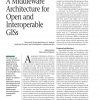Free Online Productivity Tools
i2Speak
i2Symbol
i2OCR
iTex2Img
iWeb2Print
iWeb2Shot
i2Type
iPdf2Split
iPdf2Merge
i2Bopomofo
i2Arabic
i2Style
i2Image
i2PDF
iLatex2Rtf
Sci2ools
IEEEMM
2002
2002
A Middleware Architecture for Open and Interoperable GISs
an abstract model for information sharing and integration and use it to develop an architecture for building open, component-based, interoperable systems. A geographic information system is a computer-based tool for mapping and analyzing geospatial relationships between data sets. GIS data sets tend to have complex formats and large file sizes. Moreover, the volume of data about Earth is rapidly increasing. Due to the enormous costs involved in acquiring, producing, exploiting, and disseminating geospatial data such as satellite imagery, it's practically impossible for a single organization to own all the data it needs. Current GISs are monolithic and platformdependent applications containing redundant functions and databases, and it's difficult to share GIS data and geoprocessing methods among different software and hardware platforms. They also require excessive training because of the diverse user interfaces and they lack facilities to easily accommodate new methods and da...
Data Sets | Geospatial Data | GIS Data | IEEEMM 2002 |
| Added | 19 Dec 2010 |
| Updated | 19 Dec 2010 |
| Type | Journal |
| Year | 2002 |
| Where | IEEEMM |
| Authors | Steven H. Wong, Steven L. Swartz, Dilip Sarkar |
Comments (0)

